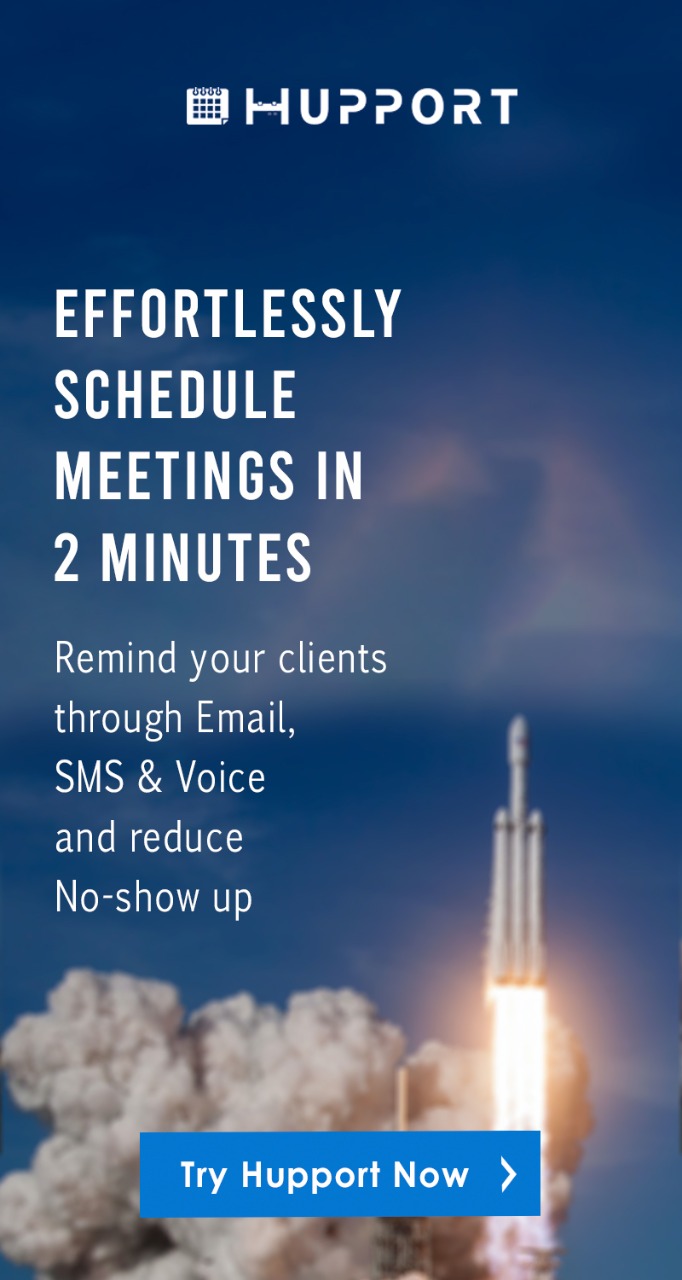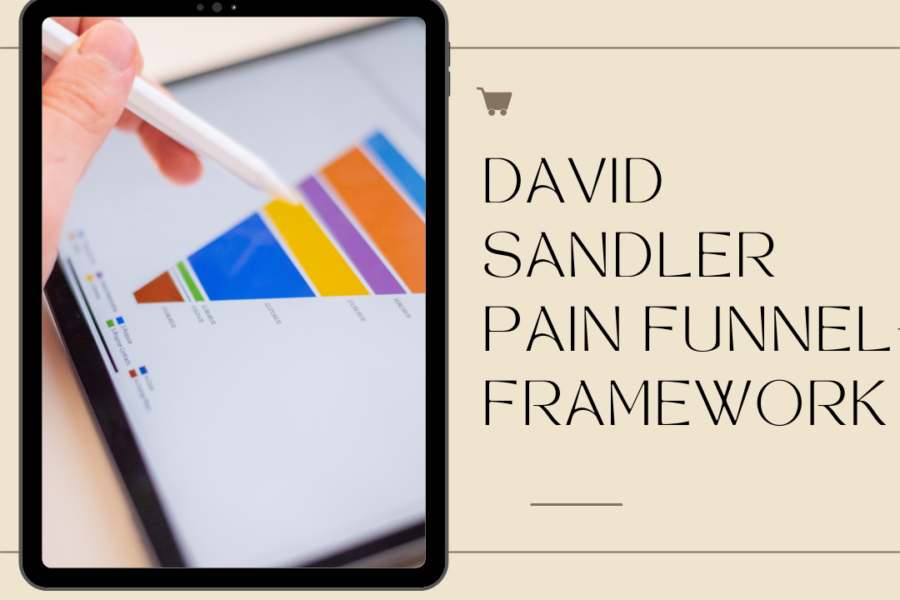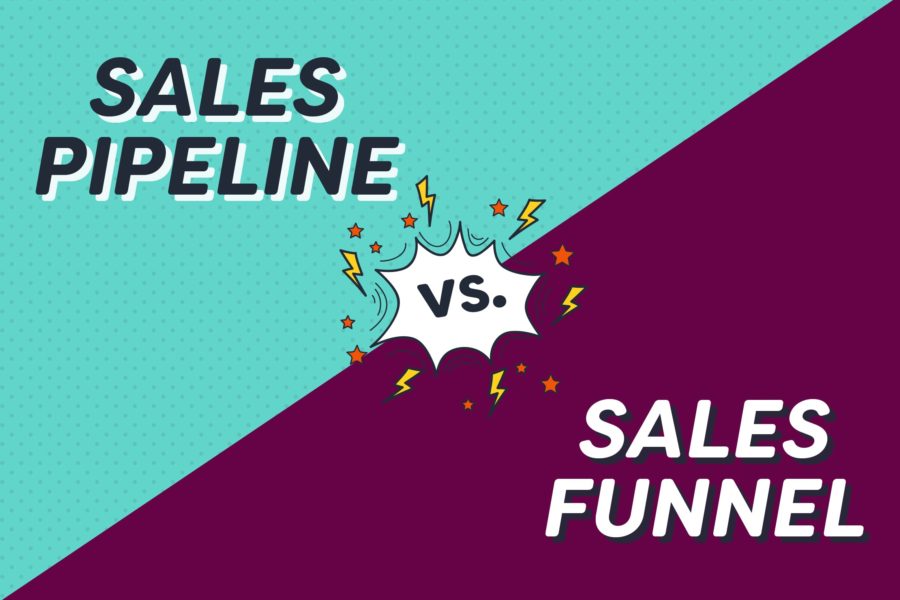Sales Funnel Stages and Case Studies 2022: A sales funnel is each step that a potential customer has to take in order to become an active or paying customer. Your sales funnel illustrates the path that prospects take through their journey to purchase an item.
A sales funnel is essentially a structured path which a potential customer passes through right from hearing about a product or business all the way down to making a purchase.
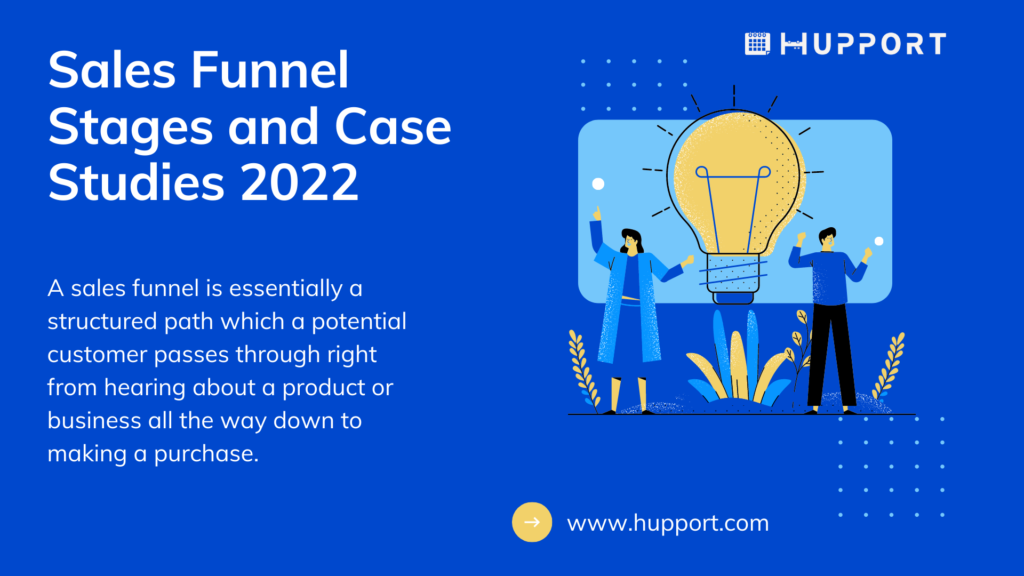
Sales Funnel Stages and Case Studies 2022
One of the most important factors to help your business grow systematically is a sales funnel.
A sales funnel helps you understand your customer’s journey. It helps you understand their behavior and how to keep them through their purchasing journey until they finally make a purchase.
Understanding your funnel can help you find the places where most prospects drop out and never convert. You can influence how prospects move through the sales funnel and whether they eventually make a purchase or not. If you don’t understand your sales funnel, you can’t know what to do at each stage, thereby losing potential customers.
A sales funnel helps you to understand the areas of your business where you need to improve in order to make more conversions and generate more revenue. Without a sales funnel, it becomes more difficult to see the areas of your business that needs improvements.
Sales Funnel Stages for Different Industries
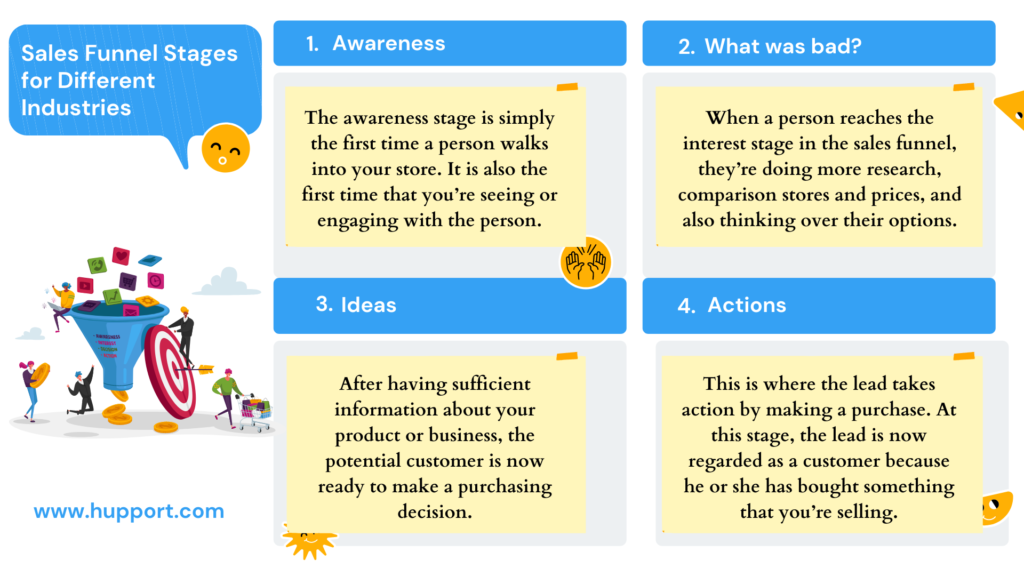
Sales Funnel Stages for Different Industries
A sales funnel is essentially in 4 stages right from when a potential customer visits your store to when a purchase is made. A person essentially visits your store as a visitor and when the person makes a purchase, he or she becomes a customer. The journey from being a visitor all through to becoming a customer happens in 4 stages.
The sales funnel stages are known by the acronym AIDA, which stands for Awareness, Interest, Decision, and Action. These four stages represent your prospective customer’s journey through the sales funnel.
While a visitor moves from one stage to another, each stage also requires a different approach from you in order not to lose the visitor.
We are going to have a detailed look at the 4 stages of a sales funnel.
Stage 1: Awareness
Awareness is the first stage of a sales funnel. This is the moment a prospect becomes aware of your product or business. This is the first time a shopper sees your store in case you have a physical store. A prospect can become aware of your business through a Facebook post, Tweet, Ads, Google search, blog post, etc.
The awareness stage is simply the first time a person walks into your store. It is also the first time that you’re seeing or engaging with the person. What the person sees in your store or what you offer will determine if the person will have interest to move further.
Stage 2: Interest
When a person reaches the interest stage in the sales funnel, they’re doing more research, comparison stores and prices, and also thinking over their options. This is the time to swoop in to get them interested in your product or business with detailed information about your product.
Here, you need to be able to woo the person into having interest in what you’re offering or selling. Share more information on the product you’re selling to capture the mind of your visitor. If the visitor is impressed and likes the product you’re offering, he or she will develop interest and move to the next stage of the funnel.
While you share more information about your product with your prospect, do not be pushy or try to sell your product right away. This can be a turn-off to prospects and chase them away. The goal here is to help the prospect make better-informed decision by establishing your expertise. Help them in any way you can to make better-informed decisions. Provide incredible content that will help them make better-informed decisions.
Stage 3: Decision
After having sufficient information about your product or business, the potential customer is now ready to make a purchasing decision. This is a crucial time when the potential customer or lead is ready to buy from you. However, the lead might still be considering other options.
Now, this is the time to convince the potential customer that your offer is the best. You need to be able to convince or encourage the potential customer to buy from you. There are various ways you can encourage a lead to buy from you. These include offering discounts, coupons, free shipping, bonus product, etc. You can develop your own ways to encourage potential customers to buy from you. Do what your competitors are not doing to encourage your lead to make a purchase. Make your offer irresistible that your lead will have no other better option other than yours.
Stage 4: Action
This is the last stage of the sales funnel. This is where the lead takes action by making a purchase. At this stage, the lead is now regarded as a customer because he or she has bought something that you’re selling. He or she purchases your product and has invariably become part of your business’s ecosystem. You have now succeeded in converting a visitor to a customer.
Just because a consumer reaches the bottom of the funnel by making a purchase doesn’t mean your work is done. You need to follow up to ensure that you retain the customer. Here, you’re focusing on customer retention. You will want the customer to come back, again and again, to make more purchases from you. There are many different ways that you can build loyal customers. Don’t forget to express gratitude for the first purchase while you develop strategies to retain your customers.
Note: In a sales funnel, not everyone that visits your store or website will finally move down the sales funnel and make a purchase. The numbers of people at the top of your sales funnel will be much more than the numbers of people at the bottom of the funnel. A lot of people will visit your store or website but only a few of them will make purchases. However, you need to aim at making as many people as possible reach the bottom of your sales funnel. Look into your sales funnel, know what people like and dislike. Make necessary amendments and get as many people as possible to make purchases.
5 Sales Funnel Case Studies to Learn From
We are going to look at some sales funnel case studies so you can learn from them and know how to apply them to your business.
Case Study 1: Basecamp
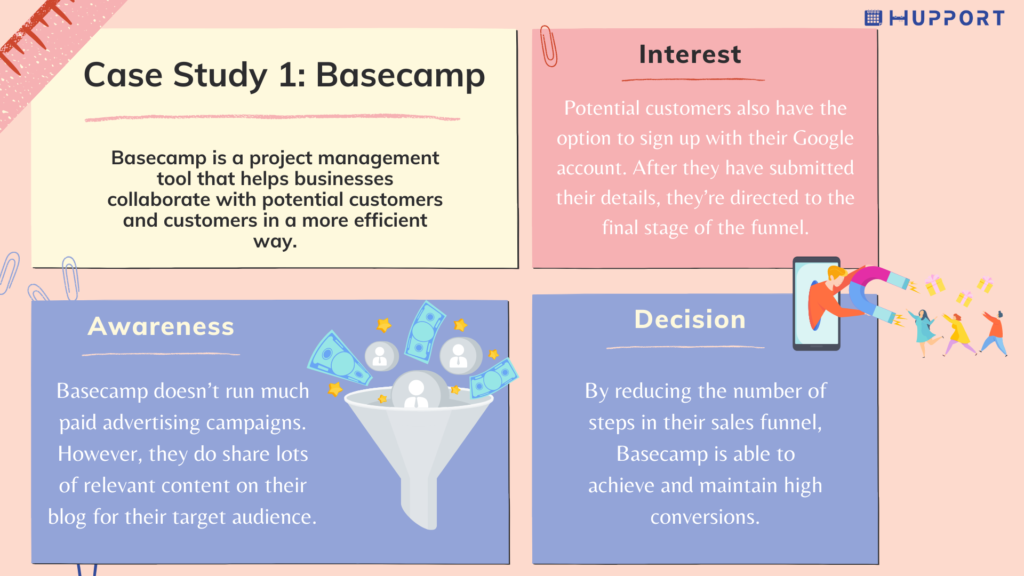
Case Study 1: Basecamp
Basecamp is a project management tool that helps businesses collaborate with potential customers and customers in a more efficient way.
They follow a similar step-by-step funnel outline. They start off by building awareness for their company and products, then drive prospects to a landing page where they have the option to express further interest in their products and services. Finally, they’re directed to a page where they can make the decision to purchase, sign up for a free trial or subscribe to a plan.
Below are the steps they take in their sales funnel:
1) Awareness
Basecamp doesn’t run much paid advertising campaigns. However, they do share lots of relevant content on their blog for their target audience. With these content, their online visitors can read much relevant information about their products and services.
2) Interest
Once potential customers click on their social media updates, blog posts, or referral links, they move through the top of the funnel and land on the company’s website home page where they’re immediately prompted for their name, e-mail address and a few other details. Potential customers also have the option to sign up with their Google account. After they have submitted their details, they’re directed to the final stage of the funnel.
3) Decision
The Decision stage is the final stage of the Basecamp sales funnel. After potential customers have signed up with their names and emails, they’re directed to a page where they have the option to sign up for a free trial. They will also be sent an e-mail on how to sign up for a free trial. Once they’ve signed up for the free trial, they can start with a sample Basecamp dashboard or create their own dashboard.
Basecamp reduces the number of stages in their sales funnel to convert more potential customers. The fewer the number of steps to take, the more people you will be able to convert into customers.
By reducing the number of steps in their sales funnel, Basecamp is able to achieve and maintain high conversions.
Case Study 2: CrazyEgg
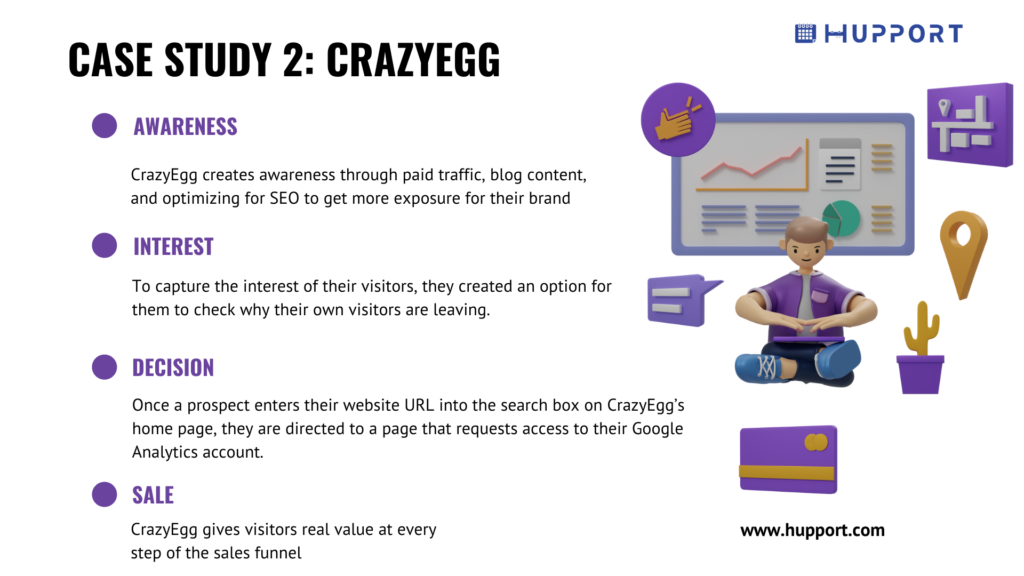
Case Study 2: CrazyEgg
CrazyEgg is a SaaS company that provides a heat map tool that helps businesses understand better how users or online visitors are interacting with their site.
CrazyEgg sales funnel is broken down into five stages:
1) Awareness
CrazyEgg creates awareness through paid traffic, blog content, and optimizing for SEO to get more exposure for their brand. By practicing all these marketing strategies, they are able to get more visitors to their website.
2) Interest
The second step in CrazyEgg’s sales funnel is directing readers to their website’s home page. To capture the interest of their visitors, they created an option for them to check why their own visitors are leaving. CrazyEgg home page visitors can enter their website’s URL on the search box to see a heat map analysis of why their visitors are leaving.
3) Decision
Once a prospect enters their website URL into the search box on CrazyEgg’s home page, they are directed to a page that requests access to their Google Analytics account. When they allow access, they’re taken to a pricing page, where they’re asked to choose from a few pricing plans depending on what they want. They need to choose a plan to be able to finish creating their CrazyEgg account.
4) Sale
Finally, when a lead selects a plan, they’re directed to a billing page where they’re required to fill out their billing information such as their names, credit card number, security code, and so on. After filling up all the necessary information, you are allowed to start a free trial for 30 days. After 30 days of the free trial, your billing starts.
CrazyEgg gives visitors real value at every step of the sales funnel. They offer a 30-day free trial period so their customers can know how the software works and also to minimize risk.
Case Study 3: How a veterinarian boosted e-commerce sales by 50%
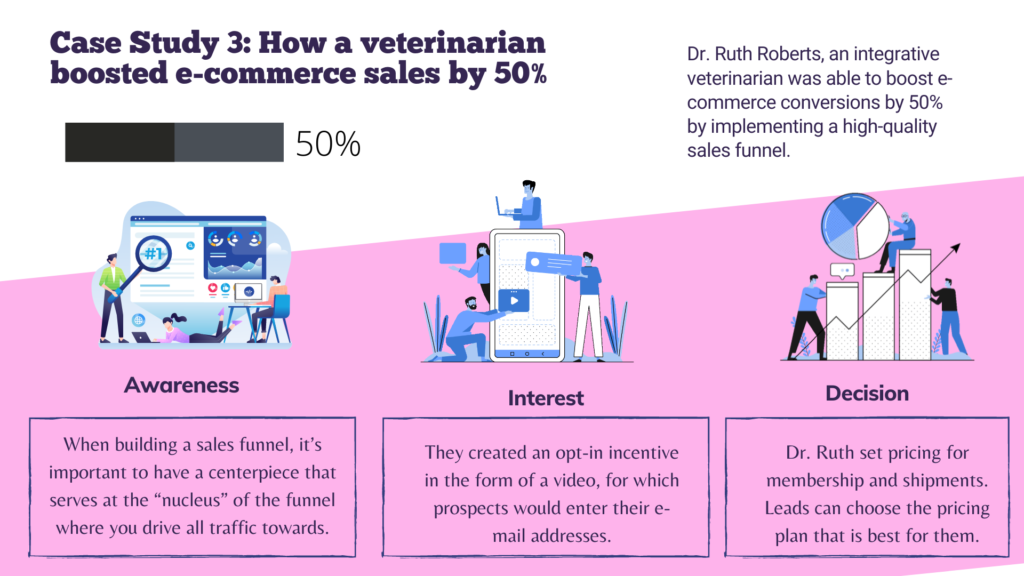
Case Study 3: How a veterinarian boosted e-commerce sales by 50%
Dr. Ruth Roberts, an integrative veterinarian was able to boost e-commerce conversions by 50% by implementing a high-quality sales funnel.
1) Awareness
When building a sales funnel, it’s important to have a centerpiece that serves at the “nucleus” of the funnel where you drive all traffic towards.
For Dr. Ruth’s campaign, the nucleus of her sales funnel was a live-action video sales letter written by Sumer Copywriting. The target audience was pet owners; hence the content of the video sales letter provided information that was valuable to pet owners. The video sales letter provided a video that shows how to give pets a better life, even if they’re sick.
To build a relationship with the audience and have their interest, the copywriting team built a lead nurturing campaign. They created a couple of campaigns such as one that targeted pet owners with older or sick dogs and cats, as well as one to help people prevent diseases in their pets. They captured leads through blog posts that offered advice on pet care. They also use Facebook ads to drive traffic.
2) Interest
They created an opt-in incentive in the form of a video, for which prospects would enter their e-mail addresses. Then, they crafted a lead nurturing campaign that once leads enter their email addresses, educational materials are sent to them over time so they can know more and build relationships. The e-mails reflected the pain points of pet owners. Sumer Copywriting wrote sales e-mails that highlighted facts, offered advice, told stories, and gave away gifts.
3) Decision
Sumer Copywriting created e-mail sequences that nurtured, offered free content, sold the program, and ultimately enhanced user experience that all helped turn prospects into customers. Dr. Ruth set pricing for membership and shipments. Leads can choose the pricing plan that is best for them.
Case Study 4: Grasshopper
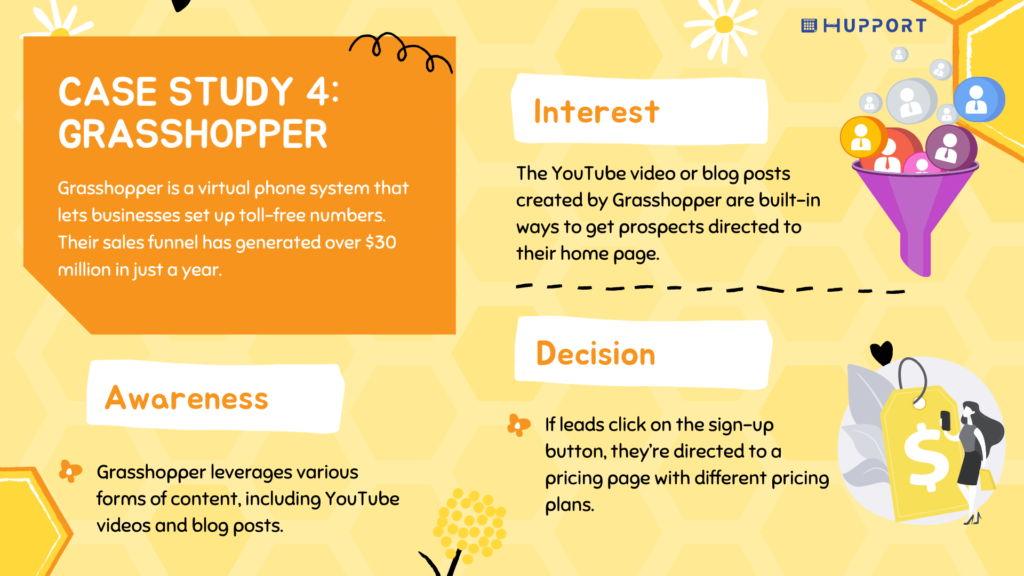
Case Study 4: Grasshopper
Grasshopper is a virtual phone system that lets businesses set up toll-free numbers. Their sales funnel has generated over $30 million in just a year.
1) Awareness
Grasshopper leverages various forms of content, including YouTube videos and blog posts. They also used paid traffic to get important information out to targeted audience. They created funny and interesting videos to further capture the interest of their audience.
2) Interest
The YouTube video or blog posts created by Grasshopper are built-in ways to get prospects directed to their home page. For example, near the end of their YouTube videos, they present a link to their website that takes prospects directly to their home page when clicked on.
On the home page, there are some interesting things that can catch prospect’s attention. They outline a few unique selling points, a money-back guarantee, and a CTA.
Once prospects click on the CTA, “see how it works,” on the home page, they’re taken to another page where they’re prompted to sign up. This page provides all the information prospects need to make a decision.
3) Decision
If leads click on the sign-up button, they’re directed to a pricing page with different pricing plans. All the plans include a 30-day money-back guarantee.
Case study 5: Telestream
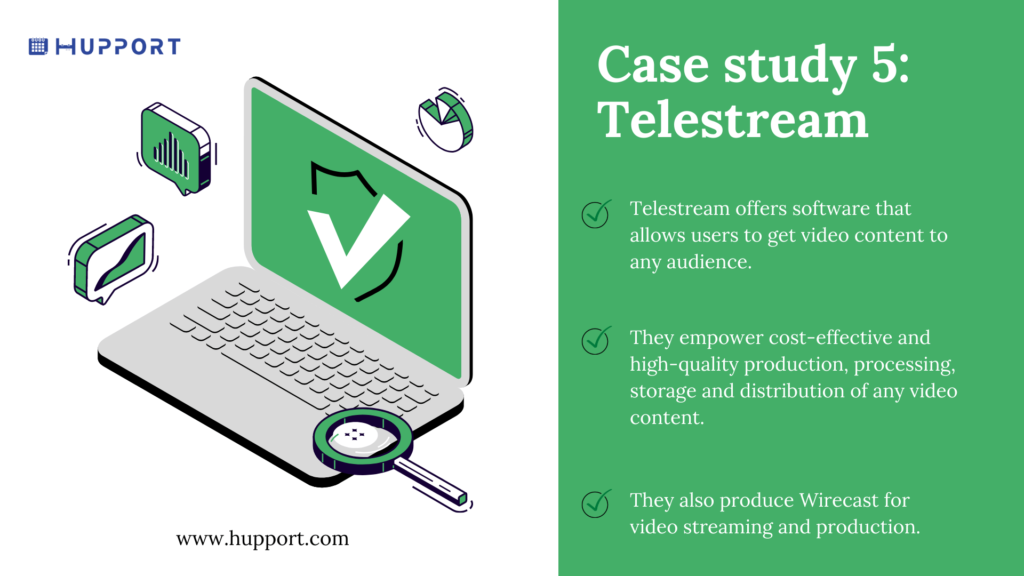
Case study 5: Telestream
Telestream offers software that allows users to get video content to any audience. They empower cost-effective and high-quality production, processing, storage and distribution of any video content. They produce a screen recording and editing product called ScreenFlow. They also produce Wirecast for video streaming and production.
Telestream was able to boost their site conversion rate, send more traffic to cart pages, increase cart conversion rate, and boost their revenue by $2 million.
Telestream drives traffic to their website through a blog and paid traffic.
They changed their site navigation which was not initially providing good results. Their site was initially confusing to users in many ways. There were many points of friction that prevented users from being able to easily purchase products from their site.
By adjusting their site navigation system, Telestream was able to achieve a site-wide boost of 4% in revenue. They adjusted the product page and also make adjustments to the CTAs. They were able to boost completed orders by 16%.

